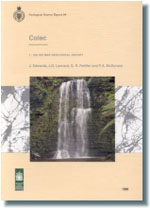GSV Report 98 - Colac 1:250 000 map area geological report
 |
| |||||||||||||||
Product description:Download The downloadable version of this report is supplied in PDF format (26.1MB). Abstract This report describes the geology of the area covered by the Colac 1:250 000 map. It contains a summary of previous work in the area, and descriptions of the physiography, stratigraphy, structure, geophysics and economic geology. Geological information has been compiled and interpreted to provide a geological history for the region. Particular emphasis is placed on the depositional environments of the Cretaceous and Tertiary sedimentary sequence of the Otway Basin, and the interrelationship between deposition, tectonic activity and relative eustatic change. The geological history of the region is divided into five major periods, recognised by changes in tectonic style and major sedimentary unconformities. Otway Group sediments were deposited during two major tectonic episodes. During the Late Jurassic to the Early Cretaceous (pre-Aptian), Australia drifted northwards from Antarctica to form a series of half-grabens in a rift across the Gondwana landmass where the Bassian Zone of southern Victoria now lies. Localised erosion of the Palaeozoic rift margins provided sediment for the early rift-fill sequence of the Casterton Formation and the Pretty Hill Formation. The Aptian to Albian period was a tectonically quiet period during which a vast quantity of Eumeralla Formation volcanolithic sediment was laid down by large braided rivers. The Eumeralla Formation is the only outcropping Cretaceous unit in the region. Sea floor spreading between Australia and Antarctica developed in the Late Cretaceous. Sherbrook Group sediments were deposited as the sea flooded into the widening rift for the first time. Marginal marine sediments of the Waarre Formation and Flaxman Formation were covered by the deep marine Belfast Mudstone. As the sea retreated, the Nullawarre Greensand and deltaic Paaratte Formation were deposited. Extensional tectonic activity continued into the Tertiary. During the Palaeocene-Oligocene thick deposits of Wangerrip Group sediments accumulated during a time of marine transgression. Deposition of marginal marine sediments of the Pebble Point Formation and their fluvial equivalents (Moomowroong Sand and Wiridjil Gravel) was followed by the accumulation of deeper water Pember Mudstone and deltaic sands of the Dilwyn Formation. Towards the end of the middle Eocene, the spreading rate between Australia and Antarctica had increased, and a wide seaway developed between the two continents. Nirranda Group sediments reflect deepening marine conditions, and progress from the marginal marine Mepunga Formation and Demons Bluff Formation to the open marine Narrawaturk Marl. The development of the circum-Antarctic current during the late Oligocene created conditions ideal for the biological production of calcium carbonate and shelf carbonate sedimentation of the Heytesbury Group. Deposition progressed from the shallow marine Clifton Formation to deeper water Gellibrand Marl and Port Campbell Limestone. Marine regression at the end of the Miocene coincided with a major change in the tectonic style of the region from predominantly extension to compression. The entire region was warped by broad folds. Regional uplift ceased by the Pliocene, and the region was covered by extensive alluvial outwash deposits of the Hanson Plain Sand. Aerial exposure led to the development of a karstic topography in Port Campbell Limestone, and lateritic soils in Hanson Plain Sand. Large outpourings of basalt covered the northern margin of the basin, and younger, explosive volcanism produced numerous scoria cones and maar craters. Earth resources in the Colac 1:250 000 map area are dominated by the extractive industries, in particular, commodities such as tuff, scoria and sand. Recent discoveries of oil and gas have rejuvenated petroleum exploration in this region. Bibliographic reference Edwards J., Leonard J.G., Pettifer G.R. and McDonald P.A., 1996. Colac 1:250 000 map geological report. Geological Survey of Victoria Report 98. Related products:
| ||||||||||||||||


